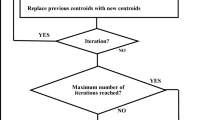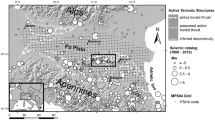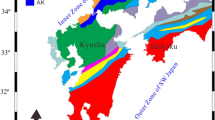Abstract
A novel methodology for obtaining a seismic zone map of India is demonstrated in this study, wherein a concrete theoretical framework is provided for deriving the zones and the respective zonal response spectra. The method involves time series clustering of uniform hazard response spectra (UHRS) that were obtained for the entire country on a 0.1° × 0.1° grid by performing probabilistic analysis corresponding to a 2475-year return period. The Euclidean distance between the UHRS values at all periods (27 data points between 0.01 s and 5 s) was taken as the similarity measure in an evolutionary particle swarm optimization algorithm. The analysis was conducted with a swarm population of 100 over 3000 iterations, and the mean UHRS of the resulting clusters was assumed as the cluster centre. Various quality/validity indices including the compactness measure, similarity measure, combined measure and Dunn Index were used to verify the results of the clustering. Based on these clusters, the entire country can be divided into seven zones, with a unique zonal spectrum for each zone.













Similar content being viewed by others
Data Availability
The models developed in this study are given as electronic supplements. Moreover, the datasets generated during and/or analysed during the current study are available from the corresponding author on reasonable request.
References
Abrahamson, N., Gregor, N., & Addo, K. (2016). BC Hydro ground motion prediction equations for subduction earthquakes. Earthquake Spectra, 32(1), 23–44.
Abrahamson, N. A., Silva, W. J., & Kamai, R. (2014). Summary of the ASK14 ground motion relation for active crustal regions. Earthquake Spectra, 30(3), 1025–1055.
Aghabozorgi, S., Shirkhorshidi, A. S., & Wah, T. Y. (2015). Time-series clustering—A decade review. Information Systems, 53, 16–38.
Ahmadi, A., Karray, F., & Kamel, M. S. (2010). Flocking based approach for data clustering. Natural Computing, 9(3), 767–791.
Atkinson, G. M., & Boore, D. M. (2003). Empirical ground-motion relations for subduction-zone earthquakes and their application to Cascadia and other regions. Bulletin of the Seismological Society of America, 93(4), 1703–1729.
Atkinson, G. M., & Boore, D. M. (2006). Earthquake ground-motion prediction equations for Eastern North America. Bulletin of the Seismological Society of America, 96(6), 2181–2205.
Basu, S., Nigam, N. (1977) “Seismic risk analysis of Indian peninsula.” In: Proceedings of 6th World Conference on Earthquake Engineering. p 782–790
Bhatia, S. C., Ravi Kumar, M., & Gupta, H. K. (1999). A probabilistic seismic hazard map of India and adjoining regions. Annali Di Geofisica, 42, 1153–1164.
BIS. (1962). IS 1893–1962: Indian standard recommendations for earthquake resistant design of structures. Bureau of Indian Standards.
Boore, D. M., Stewart, J. P., Seyhan, E., & Atkinson, G. M. (2014). NGA-west2 equations for predicting PGA, PGV, and 5% damped PSA for shallow crustal earthquakes. Earthquake Spectra, 30(3), 1057–1085.
Campbell, K. W., & Bozorgnia, Y. (2014). NGA-West2 ground motion model for the average horizontal components of PGA, PGV, and 5% damped linear acceleration response spectra. Earthquake Spectra, 30(3), 1087–1115.
Chiou, B. S. J., & Youngs, R. R. (2014). Update of the Chiou and Youngs NGA model for the average horizontal component of peak ground motion and response spectra. Earthquake Spectra, 30(3), 1117–1153.
Dhanya, J., & Raghukanth, S. T. G. (2020). Neural network-based hybrid ground motion prediction equations for western Himalayas and north-eastern India. Acta Geophysica, 68(2), 303–324.
Dunn, J. C. (1973). A fuzzy relative of the ISODATA process and its use in detecting compact well-separated clusters. Cybernetics, 3, 32–57.
Kennedy, J., & Eberhart, R. (1995) Particle swarm optimization. In Neural Networks, 1995. Proceeding, IEEE international conference, 4, (pp. 1942–1948).
Gardner, J. K., & Knopoff, L. (1974). Is the sequence of earthquakes in Southern California, with aftershocks removed, Poissonian? Bulletin of the Seismological Society of America, 64(5), 1363–1367.
Geological Survey of India (GSI) (2000) Seismotectonic Atlas of India and its Environs.
Goulet, C. A., Bozorgnia, Y., Kuehn, N., Atik, L. A., Youngs, R. R., Graves, R. W., & Atkinson, G. M. (2021). NGA-east ground-motion characterization model part 1: summary of products and model development. Earthquake Spectra, 37, 1231–1282.
Gubin, I. E. (1971). Multi-element seismic zoning (considered on the example of the Indian Peninsula). Earth Physics, 12, 10–23.
Guha, S. K. (1962). Seismic regionalization of India. In Proceedings of Symposium. Earthquake Engineering, 2nd. 191–207
Gupta, I., & Trifunac, M. (2018). Attenuation of strong earthquake ground motion–Dependence on geology along the wave path from the Hindukush subduction to western Himalaya. Soil Dynamics and Earthquake Engineering, 114, 127–146.
IBC. (2015). International building code. International Code Council, Inc.
IS: 1893. (2016). Criteria for earthquake resistant design of structures, Part 1: General provisions and buildings. Bureau of Indian Standards, Government of India, New Delhi
Kale, O. (2019). Some discussions on data-driven testing of ground-motion prediction equations under the Turkish ground-motion database. Journal of Earthquake Engineering, 23(1), 160–181.
Kamalzadeh, H., Ahmadi, A., & Mansour, S. (2017). A shape-based adaptive segmentation of time-series using particle swarm optimization. Information Systems, 67, 1–18.
Kennedy, J., Eberhart, R., & Shi, Y. (2001). Swarm intelligence. Morgan Kaufman Publishers.
Khattri, K. N., Rogers, A. M., Perkins, D. M., & Algermissen, S. T. (1984). A seismic hazard map of India and adjacent areas. Tectonophysics, 108(1–2), 93–134.
Kijko, A., & Graham, G. (1998). Parametric-historic procedure for probabilistic seismic hazard analysis Part I: Estimation of maximum regional magnitude Mmax. Pure and Applied Geophysics, 152(3), 413–442.
Krishna, J. (1959). Seismic zoning map of India. Current Science, 62, 17–23.
Lapajne, J., Motnikar, B. S., & Zupancic, P. (2003). Probabilistic seismic hazard assessment methodology for distributed seismicity. Bulletin of the Seismological Society of America, 93(6), 2502–2515.
Mohapatra, A. K., and Mohanty, W. K. (2010), “An overview of seismic zonation studies in India”, Indian Geotechnical Conference, IGS Mumbai Chapter & IIT Bombay, Dec 16–18, 2010.
NDMA. (2010). Development of probabilistic seismic hazard map of India. The National Disaster Management Authority, Government of India.
NDMA (2022), “probabilistic seismic hazard map of India”, The National Disaster Management Authority, Government of India, New Delhi, https://ndma.gov.in/sites/default/files/PDF/Technical%20Documents/NDMA_PSHMI.pdf. Last accessed on 20/04/2022.
Parvez, I. A., Vaccari, F., & Panza, G. F. (2003). A deterministic seismic hazard map of India and adjacent areas. Geophysical Journal International, 155(2), 489–508.
Piotrowski, A. P., Napiorkowski, J. J., & Piotrowska, A. E. (2020). Population size in particle swarm optimization. Swarm and Evolutionary Computation, 58, 100718.
Singh, S., Srinagesh, D., Srinivas, D., Arroyo, D., Perez-Campos, X., Chadha, R., Suresh, G., & Suresh, G. (2017). Strong ground motion in the Indo-Gangetic plains during the 2015 Gorkha, Nepal, earthquake sequence and its prediction during future earthquakes. Bulletin of the Seismological Society of America, 107(3), 1293–1306.
Sreejaya, K. P., Raghukanth, S. T. G., Gupta, I. D., Murty, C. V. R., and Srinagesh, D. (2022), “Seismic hazard map of India and neighboring regions”, Soil Dynamics and Earthquake Engineering (Under review).
Tandon, A. N. (1956). Zones of India liable to earthquake damage. Indian Journal of Meteorology and Geophysics, 10, 137–146.
Uhrhammer, R. A. (1986). Characteristics of northern and central California seismicity. Earthquake Notes, 57(1), 21.
Weichert, D. H. (1980). Estimation of the earthquake recurrence parameters for unequal observation periods for different magnitudes. Bulletin of the Seismological Society of America, 70(4), 1337–1346.
Youngs, R. R., Chiou, S. J., Silva, W. J., & Humphrey, J. R. (1997). Strong ground motion attenuation relationships for subduction zone earthquakes. Seismological Research Letters, 68(1), 58–73.
Yu, Y., Gao, M., & Xu, G. (2011). Seismic Zonation. In H. K. Gupta (Ed.), Encyclopedia of solid earth geophysics. Encyclopedia of earth sciences series (pp. 1224–1230). Springer.
Zhao, J. X., Zhang, J., Asano, A., Ohno, Y., Oouchi, T., Takahashi, T., Ogawa, H., Irikura, K., Thio, H. K., Somerville, P. G., et al. (2006). Attenuation relations of strong ground motion in Japan using site classification based on predominant period. Bulletin of the Seismological Society of America, 96(3), 898–913.
Funding
The authors declare that no funds, grants, or other support were received for this project or during the preparation of this manuscript. The authors have no relevant financial or non-financial interests to disclose.
Author information
Authors and Affiliations
Contributions
STG contributed to the conceptualization and supervision of this work, whereas concept development, data collection, analysis and preparation of the manuscript were performed by the corresponding author BP.
Corresponding author
Ethics declarations
Conflict of Interest
The authors declare that they have no conflict of interest.
Additional information
Publisher's Note
Springer Nature remains neutral with regard to jurisdictional claims in published maps and institutional affiliations.
Appendices
Appendix A
Particle Swarm Optimization
Particle swarm optimization (PSO), which is an evolutionary algorithm, makes use of the nature-bound swarm intelligence technique in solving an optimization problem (Kennedy & Eberhart, 1995). The logic in the algorithm is based on the natural behaviour or movement of birds/fishes in a swarm (flock/school). In the algorithm, a set of particles with memory are considered to fill the solution space. The particles have an adaptable velocity, which determines their movement in the search space towards the solution.
The PSO algorithm starts with initialization of the position vectors (xi) of all the particles in the swarm. These position vectors are assumed to be the solutions of the optimization problem. Each of these particles also has velocity vectors (vi), which determines its respective position in the subsequent time step, as given by Eq. 2. At every iteration, the objective function or cost function is evaluated based on the particle’s position xi and the best position for the ith particle in the swarm is estimated. Since all the particles have memory, the current best position is compared against the personal best position (Pbest), which might have been observed in any of the previous iterations. Simultaneously, a global best position (Gbest) is obtained through comparison of all the particles’ positions in the swarm. Accordingly, based on the Pbest and Gbest values, the velocity of the particle i is updated (Eq. 1) and the procedure is repeated for all the n iterations to obtain new positions for all the particles (Eq. 2). It should be noted that in each of these iterations, the position of the particle is updated towards the global best position, mimicking the swarm phenomena.
Here, w is the inertia weight; c1 is the cognitive acceleration parameter; c2 is the social acceleration parameter; r1 and r2 are uniformly distributed random numbers bounded by [0 1] (Kennedy et al., 2001). The change in velocity and the bounds of the increased velocity at every time step is governed by the parameter w and the upper bound of the velocity vector (Vmax). Consequently, the maximum step size of a particle in a single iteration is governed by parameters c1 and c2, whereas r1 and r2 maintain the population diversity. The bounds for the velocity vector are obtained using Eqs. 3 and 4.
Rights and permissions
Springer Nature or its licensor (e.g. a society or other partner) holds exclusive rights to this article under a publishing agreement with the author(s) or other rightsholder(s); author self-archiving of the accepted manuscript version of this article is solely governed by the terms of such publishing agreement and applicable law.
About this article
Cite this article
Podili, B., Raghukanth, S.T.G. Seismic Zone Map for India Based on Cluster Analysis of Uniform Hazard Response Spectra. Pure Appl. Geophys. 180, 3269–3288 (2023). https://doi.org/10.1007/s00024-023-03329-4
Received:
Revised:
Accepted:
Published:
Issue Date:
DOI: https://doi.org/10.1007/s00024-023-03329-4




